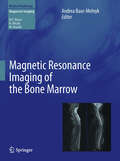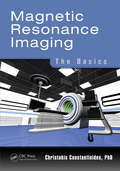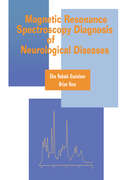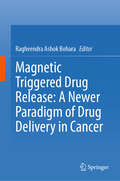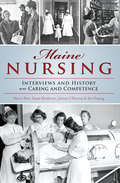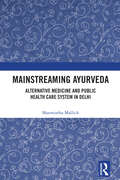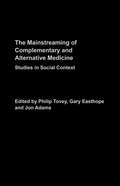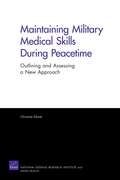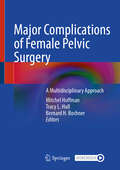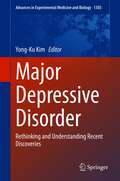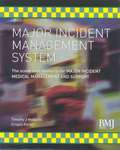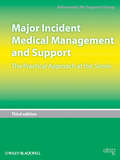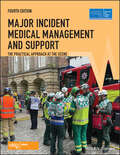- Table View
- List View
Magnetic Resonance Imaging of the Bone Marrow
by Andrea Baur-MelnykOn account of its unrivalled imaging capabilities and sensitivity, magnetic resonance imaging (MRI) is considered the modality of choice for the investigation of physiologic and pathologic processes affecting the bone marrow. This book describes the MRI appearances of both the normal bone marrow, including variants, and the full range of bone marrow disorders. Detailed discussion is devoted to malignancies, including multiple myeloma, lymphoma, chronic myeloproliferative disorders, leukemia, and bone metastases. Among the other conditions covered are benign and malignant compression fractures, osteonecrosis, hemolytic anemia, Gaucher's disease, bone marrow edema syndrome, trauma, and infective and non-infective inflammatory disease. Further chapters address the role of MRI in assessing treatment response, the use of contrast media, and advanced MRI techniques. Magnetic Resonance Imaging of the Bone Marrow represents an ideal reference for both novice and experienced practitioners.
Magnetic Resonance Imaging of the Knee
by Ali Guermazi Daichi Hayashi Mamoru NiitsuThis abundantly illustrated atlas of MR imaging of the knee documents normal anatomy and a wide range of pathologies. In addition to the high-quality images, essential clinical information is presented in bullet point lists and diagnostic tips are included to assist in differential diagnosis. Concise explanations and guidance are also provided on the MR pulse sequences suitable for imaging of the knee, with identification of potential artifacts. This book will be an invaluable asset for busy radiologists, from residents to consultants. It will be ideal for carrying at all times for use in daily reading sessions and is not intended as a reference to be read in the library or in non-clinical settings.
Magnetic Resonance Imaging: The Basics (Latest Advances In Clinical And Pre-clinical Cardiovascular Magnetic Resonance Imaging Ser.)
by Christakis ConstantinidesMagnetic resonance imaging (MRI) is a rapidly developing field in basic applied science and clinical practice. Research efforts in this area have already been recognized with five Nobel prizes awarded to seven Nobel laureates in the past 70 years. Based on courses taught at The Johns Hopkins University, Magnetic Resonance Imaging: The Basics provides a solid introduction to this powerful technology. <P><P>The book begins with a general description of the phenomenon of magnetic resonance and a brief summary of Fourier transformations in two dimensions. It examines the fundamental principles of physics for nuclear magnetic resonance (NMR) signal formation and image construction and provides a detailed explanation of the mathematical formulation of MRI. Numerous image quantitative indices are discussed, including (among others) signal, noise, signal-to-noise, contrast, and resolution. The second part of the book examines the hardware and electronics of an MRI scanner and the typical measurements and simulations of magnetic fields. It introduces NMR spectroscopy and spectral acquisition and imaging techniques employing various pulse sequences. The final section explores the advanced imaging technique of parallel imaging. Structured so that each chapter builds on the knowledge gained in the previous one, the book is enriched by numerous worked examples and problem sets with selected solutions, giving readers a firm grasp of the foundations of MRI technology.
Magnetic Resonance Neuroimaging
by Jeff W.M. Bulte Michel ModoThe advent of non-invasive imaging technology, such as magnetic resonance imaging (MRI), has allowed biologists and clinicians to make great strides in unraveling the secrets of the brain. In Magnetic Resonance Neuroimaging: Methods and Protocols, expert researchers in the field provide a comprehensive collection of experimental MRI protocols that can be used to non-invasively interrogate the healthy and diseased brain. The chapters are divided into general techniques, such as the measurement of relaxivity, magnetic resonance spectroscopy, diffusion tensor imaging, and MR reporter genes, as well as specific applications in brain imaging, for example, phenotyping transgenic animals, detecting amyloid plaques, and fMRI in psychiatry. As a volume in the highly successful Methods in Molecular BiologyTM series, this work contains the type of detailed description and implementation advice that is crucial for getting optimal results. Thorough and cutting-edge, Magnetic Resonance Neuroimaging: Methods and Protocols serves neuroscientists, clinical neurologists, psychiatrists, and radiologists with an excellent compendium of methods easily applied to both animal and human studies and certain to be an excellent resource for translational research.
Magnetic Resonance Procedures: Health Effects and Safety
by Frank G. ShellockMagnetic Resonance Procedures: Health Effects and Safety is the first authoritative text on MR procedures and its associated health and safety concerns written by noted radiologists, physicists, and scientists with expertise in the field. It contains both theoretical and practical information. This timely text discusses emergent issues rela
Magnetic Resonance Spectroscopy Diagnosis of Neurological Diseases
by Else Rubæk Danielsen Brian RossDemonstrates how MRS offers a useful tool for the noninvasive biochemical analysis of the brain. The book covers over 70 clinical cases and more than 100 spectra that enhance skills at interpreting MRS, including minimizing errors, highlighting artifacts, and expanding the clinical usefulness of this diagnostic modality.
Magnetic Resonance Spectroscopy of Degenerative Brain Diseases
by Gülin ÖzThe proposed book will act as a guide for scientists and clinicians to the unique information that MRS can provide. It will be a comprehensive overview of clinical and pre-clinical MRS applications and potential clinical utility of MRS biomarkers in degenerative brain diseases from leading experts in the field. MRS has proven to be a powerful complementary tool to MRI for the diagnosis and monitoring of disease progression and response to treatment because it can detect changes in cell density, cell type, and biochemical composition, not just structural changes. As the population in the developed world continues to age, neuroimaging for diagnosis, prognosis, and therapy monitoring of neurodegenerative diseases becomes increasingly important and there has been a recent surge of clinical and pre-clinical applications of MRS indicating that this technique can provide robust and non-invasive biomarkers of degeneration.
Magnetic Resonance Spectroscopy of Degenerative Brain Diseases (Contemporary Clinical Neuroscience)
by Gülin ÖzThe proposed book will act as a guide for scientists and clinicians to the unique information that MRS can provide. It will be a comprehensive overview of clinical and pre-clinical MRS applications and potential clinical utility of MRS biomarkers in degenerative brain diseases from leading experts in the field. MRS has proven to be a powerful complementary tool to MRI for the diagnosis and monitoring of disease progression and response to treatment because it can detect changes in cell density, cell type, and biochemical composition, not just structural changes. As the population in the developed world continues to age, neuroimaging for diagnosis, prognosis, and therapy monitoring of neurodegenerative diseases becomes increasingly important and there has been a recent surge of clinical and pre-clinical applications of MRS indicating that this technique can provide robust and non-invasive biomarkers of degeneration.
Magnetic Surgery
by Michel GagnerThe book encompasses the different concepts and designs using magnets for surgical purposes. It provides a concise yet comprehensive summary of the current status of the field that will help guide patient management and stimulate investigative efforts. The text reviews new data about interventions in all medical and surgical fields. Written by experts in their fields, topics focus on endoluminal and laparoscopic operations, techniques from vascular and GI anastomosis. The book demonstrates the use of magnets to treat a variety of diseases such as reflux, back pain, and fecal incontinence. The reader will learn how to retract and gain exposure, dissect tissue planes, achieve hemostasis, and create anastomosis in a totally different way. Physical properties of external surface and internal magnets are discussed. The authors emphasize the importance of partnering with industry leaders to develop novel surgical tools.By harnessing the power of attraction, the energy and might of magnets, Magnetic Surgery serves as a valuable resource for clinicians, surgeons and researchers in biomedical engineering interested in this form of energy and physical metal properties. In utilizing these properties, the book seeks to improve surgical outcomes of patients worldwide.
Magnetic Triggered Drug Release: A Newer Paradigm of Drug Delivery in Cancer
by Raghvendra Ashok BoharaThis book discusses the potential of magnetic nanoparticles in cancer therapy. It reviews the synthesis of magnetic nanoparticles – which, due to their small size and processability, have become widely used in various biomedical applications – and their role in cancer diagnosis, drug delivery, and personalized medicine. It presents the applications of magnetic nanoparticle in the destruction of tumor cells by heating them to their apoptosis threshold. It also introduces the new perspective in the development of magnetic field induced drug release in the cancer treatment. Importantly, the book covers the innovative three arm approach in cancer treatment by magnetic nanoparticles through inducing apoptosis, activating the immune response, and targeted-drug delivery. It highlights various novel approaches to improve the biocompatibility, half-life, and biodegradability of magnetic nanoparticles. In closing, the book offers comprehensive descriptions of numerous challenges involved in applying magnetic nanoparticles to cancer treatment.
Magnetoencephalography
by Selma Supek Cheryl J. AineMagnetoencephalography (MEG) is an invaluable functional brain imaging technique that provides direct, real-time monitoring of neuronal activity necessary for gaining insight into dynamic cortical networks. Our intentions with this book are to cover the richness and transdisciplinary nature of the MEG field, make it more accessible to newcomers and experienced researchers and to stimulate growth in the MEG area. The book presents a comprehensive overview of MEG basics and the latest developments in methodological, empirical and clinical research, directed toward master and doctoral students, as well as researchers. There are three levels of contributions: 1) tutorials on instrumentation, measurements, modeling, and experimental design; 2) topical reviews providing extensive coverage of relevant research topics; and 3) short contributions on open, challenging issues, future developments and novel applications. The topics range from neuromagnetic measurements, signal processing and source localization techniques to dynamic functional networks underlying perception and cognition in both health and disease. Topical reviews cover, among others: development on SQUID-based and novel sensors, multi-modal integration (low field MRI and MEG; EEG and fMRI), Bayesian approaches to multi-modal integration, direct neuronal imaging, novel noise reduction methods, source-space functional analysis, decoding of brain states, dynamic brain connectivity, sensory-motor integration, MEG studies on perception and cognition, thalamocortical oscillations, fetal and neonatal MEG, pediatric MEG studies, cognitive development, clinical applications of MEG in epilepsy, pre-surgical mapping, stroke, schizophrenia, stuttering, traumatic brain injury, post-traumatic stress disorder, depression, autism, aging and neurodegeneration, MEG applications in cognitive neuropharmacology and an overview of the major open-source analysis tools.
Maillard Reaction in Foods: Mitigation Strategies and Positive Properties (SpringerBriefs in Molecular Science)
by Salvatore Parisi Sara M. Ameen Anna Santangelo Shana MontaltoThis book provides an overview of mitigation strategies and positive health effects of Maillard Reaction products in the contexts of food processing and storage. The effects of Maillard Reactions can vary considerably: while on the one hand certain sensorial alterations and influences on color, flavor and odor may be desirable, Maillard Reactions can also result in potentially harmful and toxic products (e.g. furfurals, furosines, or acrylamide). This book discusses possible mitigation strategies for the reduction of toxic reaction products, including the addition of enzymes or antioxidants, reducing sugars, and encapsulation approaches, as well as new processing strategies, such as high-pressure, radio-frequency, ultrahigh-temperature, or Ohmic heating methods. The book also illustrates that certain Maillard products can even produce positive health effects, e.g. antimicrobial or anticarcinogenic effects. The methods described here can serve as a blueprint for promoting the formation of beneficial compounds and reducing / avoiding toxic substances, offering essential strategies and methods.
Maimonides
by Sherwin B. NulandMoses Maimonides was a Renaissance man before there was a Renaissance: a great physician who served a sultan, a dazzling Torah scholar, a community leader, a daring philosopher whose greatest work--The Guide for the Perplexed--attempted to reconcile scientific knowledge with faith in God. He was a Jew living in a Muslim world, a rationalist living in a time of superstition. Eight hundred years after his death, his notions about God, faith, the afterlife, and the Messiah still stir debate; his life as a physician still inspires; and the enigmas of his character still fascinate. Sherwin B. Nuland, best-selling author of How We Die, focuses his surgeon's eye and writer's pen on this greatest of rabbis, most intriguing of Jewish philosophers, and most honored of Jewish doctors. He gives us a portrait of Maimonides that makes his life, his times, and his thought accessible to the general reader as they have never been before.
Maine Nursing: Interviews and History on Caring and Competence
by Susan Henderson Valerie Hart Juliana L'Heureux Ann SossongMaine nurses have served tirelessly as caregivers and partners in healing at home and abroad, from hospitals to battlefields. The Division of Public Health Nursing and Child Hygiene was established in 1920 to combat high rates of infant mortality in Washington and Aroostook Counties. During the Vietnam War, Maine nurses helped build the Twelfth Evacuation Hospital at Cu Chi and bravely assisted surgeries in the midst of fighting. In the early 1980s, nurse disease prevention educators in Portland rose to the challenge of combating the growing AIDS epidemic. Through historical anecdotes and fascinating oral histories, discover the remarkable sacrifices and achievements of Maine's nurses.
Mainstreaming Ayurveda: Alternative Medicine and Public Health Care System in Delhi
by Sharmistha MallickThis book brings concepts, practices of Ayurveda and its interface with modern health care set-up in Delhi, India. It presents a new conceptual framework in studying public health in India, offers policy recommendations and outlines the challenges of mainstreaming of alternative medical systems in India.Drawing on a wealth of primary data that looks at the social profile of patients, gender, disease profile of patients, prescriptions, average cost per prescription and kinds of medicines prescribed, the monograph explores patterns of health behaviour through the perceptions of doctors and patients, administrators and their negotiations with the bureaucratic health structure. It analyses the power and structures between practitioners of modern medicine and Ayurvedic doctors and the issues of cross referral and formal and informal levels of interaction/network between the two medical systems. Engaging with current debates around public health in India, the volume will be of interest to scholars and researchers of public health and sociology of health and medicine, public policy and public administration and South Asian studies.
Mainstreaming Complementary and Alternative Medicine: Studies in Social Context
by Jon Adams Gary Easthope Philip ToveyStepping back from the immediate demands of policy-making, Mainstreaming Complementary and Alternative Medicine allows a complex and informative picture to emerge of the different social forces at play in the integration of CAM with orthodox medicine. Complementing books that focus solely on practice, it will be relevant reading for all students following health studies or healthcare courses, for medical students and medical and healthcare professionals.
Mainstreaming Equality in the European Union: Education, Training And Labour Market Policies
by Teresa ReesMainstreaming Equality in the European Union provides a critical overview and evaluation of the potential role of the EU in perpetuating or breaking down gender segregation in the EU labour force. Teresa Rees draws upon feminist theoretical frameworks in assessing Equal Opportunitues policies and the role of training in the labour market. The same economic imperatives which put women's training on the agenda have heightened interest in designing training which attracts women into mainstream provision. Mainstreaming Equality in the European Union addresses the urgent need for academics, education and training providers, as well as policy makers to be aware of current thinking at EU level on training policy.
Mainstreaming Midwives: The Politics of Change
by Robbie Davis-Floyd Christine Barbara JohnsonProviding insights into midwifery, a team of reputable contributors describe the development of nurse- and direct-entry midwifery in the United States, including the creation of two new direct-entry certifications, the Certified Midwife and the Certified Professional Midwife, and examine the history, purposes, complexities, and the political strife that has characterized the evolution of midwifery in America.Including detailed case studies, the book looks at the efforts of direct-entry midwives to achieve legalization and licensure in seven states: New York, Florida, Michigan, Iowa, Virginia, Colorado, and Massachusetts with varying degrees of success.
Maintaining Military Medical Skills During Peacetime
by Christine EibnerMilitary medical personnel are tasked with fulfilling both the benefits mission and the readiness mission of the U.S. Department of Defense (DoD). However, the medical skills required during deployment are likely to differ significantly from those required during peacetime. This study explored an arrangement in which some personnel are stationed in nonmilitary settings where the case mix might more closely resemble that expected under deployment.
Maintaining a Healthy Lifestyle: Psychological Interventions for the Prevention of Chronic Diseases and the Role of the Health Ecosystem
by Dorothea Schaffner Adrienne Schäfer Karina von dem Berge Nora Studer Nico van der Heiden Anja ZimmermannWith a sustainable lifestyle change based on sufficient exercise and a balanced diet, many chronic diseases (obesity, high blood pressure, diabetes, metabolic syndrome) can be alleviated, cured or their onset prevented. Those affected from chronic diseases find it difficult to change their lifestyle permanently. Intervention programs are often not geared towards sustainable behavioral change and take too little account of the individual's motivational factors. As a result, those affected revert to old patterns after a while. The applied research project "Sustainable Lifestyle Change", which is the subject of this book, deals with the question of how "sticking to" a healthy lifestyle can be supported from the perspective of motivational psychology and service orientation. This specialist book is aimed at people in the healthcare sector (health psychologists, doctors, nutritionists, etc.) as well as applied researchers and explains how affected people can be supportedin "sticking to" a healthy lifestyle. There are gaps in research and practice regarding this so-called maintenance phase of a healthy lifestyle, which this book closes: What measures successfully support those affected from chronic diseases in making sustainable lifestyle changes? What is the role of motivation and motivational orientation in maintaining a healthy lifestyle? What does the maintenance phase look like and what is the customer journey of those affected? What is the role of those affected and other stakeholders in the healthcare ecosystem in long-term lifestyle change? The findings are synthesized in a toolbox with recommendations for practitioners.
Major Complications of Female Pelvic Surgery: A Multidisciplinary Approach
by Tracy L. Hull Mitchel Hoffman Bernard H. BochnerThis book gives a multidisciplinary perspective on complications of female pelvic surgery. The confined space of the pelvis precludes a clear separation of the pelvic surgical disciplines, and pelvic surgery is therefore multidisciplinary by nature. This work addresses this overlap by featuring three editors, one from each of the major pelvic surgery disciplines: gynecology, urology, and colorectal surgery. The chapters are broken down into medical, surgical, and procedure-related complications, and address each complication’s background, prevention, recognition, and management. Written by experts in the field, this book is an easy-to-use resource for all surgeons who perform pelvic operations.
Major Depressive Disorder: Rethinking and Understanding Recent Discoveries (Advances in Experimental Medicine and Biology #1305)
by Yong-Ku KimThis book reviews all aspects of major depressive disorder (MDD), casting light on its neurobiological underpinnings and describing the most recent advances in management. The book is divided into four sections, the first of which discusses MDD from a network science perspective, highlighting the alterations in functional and structural connectivity and presenting insights achieved through resting state functional MRI and the development of neuroimaging-based biomarkers. The second section examines important diagnostic and neurobiological issues, while the third considers the currently available specific treatments for MDD, including biofeedback, neurofeedback, cognitive behavioral therapy, acceptance and commitment therapy, neuromodulation therapy, psychodynamic therapy, and complementary and alternative medicine. A concluding section is devoted to promising emerging treatments, from novel psychopharmacological therapies through to virtual reality treatment, immunotherapy, biomarker-guided tailored therapy, and more. Written by leading experts from across the world, the book will be an excellent source of information for both researchers and practitioners.
Major Incident Management System (MIMS), 1st Edition
by Timothy J. Hodgetts Crispin PorterThis highly practical aid to management of major incidents is the refined and improved new edition of Prehospital Emergency Management Master. Concentrating on the essential elements in treatment and transport of the wounded in a major incident this new system provides easily assimilable information on:symbols and terminology; first actions; METHANE report; command; safety; communications; triage; treament; transportthe system is produced on waterproof pages, and includes 12 separate action cards for use by auxiliary helpers, and a log for recording the facts.The complete package comes in a handy sized ring binder, allowing users to add their own local notes. The use of colour and easily recognisable icons makes this a valuable aid even in the most difficult conditions.
Major Incident Medical Management and Support, THIRD EDITION
by Kevin Mackway-JonesMajor Incident Medical Management and Support (MIMMS) is the coursebook for the Advanced Life Support Group's internationally taught training for health care professionals responding to major incidents. The practical approach employed in MIMMS has proved an invaluable aid to both civilian and military doctors, nurses and paramedics working in disaster management worldwide. The third edition has been fully revised to make MIMMS appropriate for the 21st century, with greater emphasis on human factors, a more structured approach to medical management, and new chapters on: Hazardous materials Incidents involving large numbers of children Management of a major incident with multiple burn casualties Mass gatherings Natural disasters There are also revised appendices covering responsibility for the dead, radio use, and voice procedures, and what to do beyond the immediate situation. Covering all eventualities in medical management during major incidents, MIMMS provides a comprehensive and practical guide for all who are involved in this aspect of emergency medicine.
Major Incident Medical Management and Support: The Practical Approach at the Scene (Advanced Life Support Group)
by Advanced Life Support GroupThe Major Incident Medical Management and Support (MIMMS) course, developed by the Advanced Life Support Group (ALSG), is taught to healthcare professionals worldwide. Integrated into both civilian and military medical practice, MIMMS is the only international standard in major incident medical management – focused on delivering the medical support needed to many casualties through triage, treatment and transport. The Fourth Edition of Major Incident Medical Management and Support: The Practical Approach at the Scene is the most current coursebook for the MIMMS curriculum. This new edition has been fully revised to ensure doctors, nurses and paramedics are able to prepare for, and implement, a structured response to major incidents such as those involving hazardous materials, natural disasters, mass gatherings, multiple burn casualties and large numbers of children. The wide range of topics covered include communications, personal and medical equipment, command and control, planning, assessment and the psychological aspects of major incidents. This new edition also includes: Practical information and clear guidelines for medical professionals delivering care to multiple casualties at the scene both during and after an incident The organisations, structures and different roles involved in the medical management of major incidents Contributions from an international team of experts in fields including emergency medicine and nursing, fire and rescue services, disaster preparedness and response and emergency transport Appendices covering responsibility for the dead, radio use and voice procedures, the media, the hospital response and the steps to take beyond the immediate situation Major Incident Medical Management and Support is required reading for all those undertaking the MIMMS education programme. <p><p> The Advanced Life Support Group (ALSG) improves outcomes for people in life-threatening situations, anywhere along the healthcare pathway, anywhere in the world. ALSG is a leading medical education charity and have delivered advanced life support training to over 225 000 clinicians in 44 countries, across 5 continents, for over 25 years. For more information on the complete range of Wiley medical student and junior doctor publishing, please visit: www.wiley.com For more information on the Advanced Life Support Group, please visit: www.alsg.org To receive automatic updates on Wiley books and journals, join our email list. Sign up today at www.wiley.com/email This new edition is also available as an e-book. For more details, please see www.wiley.com/buy/9781119348382 TITLES OF RELATED INTEREST Major Incident Medical Management and Support: The Practical Approach in the Hospital,2nd Edition Advanced Life Support Group 9781119501015 December 2018 Pre-Obstetric Emergency Training: A Practical Approach 2nd Edition Advanced Life Support Group 9781119348382 August 2018 Pre-Hospital Paediatric Life Support: A Practical Approach to Emergencies 3rd Edition Advanced Life Support Group 9781118339763 October 2017
